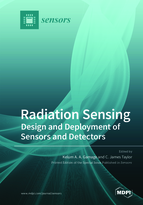Radiation Sensing: Design and Deployment of Sensors and Detectors
A special issue of Sensors (ISSN 1424-8220). This special issue belongs to the section "Intelligent Sensors".
Deadline for manuscript submissions: closed (30 April 2020) | Viewed by 39537
Special Issue Editors
Interests: educational development and innovation; engineering education; quality assurance and enhancement in engineering programmes; radiation detection and instrumentation
Special Issues, Collections and Topics in MDPI journals
Special Issue Information
Dear Colleague,
Radiation sensing is important in many fields, and it poses significant challenges for sensing instrument designers. Radiation sensing instruments, particularly for nuclear decommissioning and security applications, are required to operate in unknown environments and should detect and characterise radiation fields in real-time. This Special Issue solicits recent advances in radiation sensing technology, with a particular focus on instrument design and deployment.
The issue will report on the latest developments in the use of ground-based and aerial robots in the deployment of such sensors. For example, robots reduce the need for manned entry into radioactive environments e.g. areas of high beta/gamma mixed wastes, a widespread problem in the context of UK nuclear power plants. These are challenging and unstructured environments for the deployment of robotic solutions.
This Special Issue will cover both theory and practice. Articles concerning, for example, radiation sensing instrument design, real-time data processing, radiation simulation and experimental work, robot design, control systems, task planning and radiation shielding will all be considered, among other relevant topics.
Dr. Kelum A. A. Gamage
Prof. C. James Taylor
Guest Editors
Manuscript Submission Information
Manuscripts should be submitted online at www.mdpi.com by registering and logging in to this website. Once you are registered, click here to go to the submission form. Manuscripts can be submitted until the deadline. All submissions that pass pre-check are peer-reviewed. Accepted papers will be published continuously in the journal (as soon as accepted) and will be listed together on the special issue website. Research articles, review articles as well as short communications are invited. For planned papers, a title and short abstract (about 100 words) can be sent to the Editorial Office for announcement on this website.
Submitted manuscripts should not have been published previously, nor be under consideration for publication elsewhere (except conference proceedings papers). All manuscripts are thoroughly refereed through a single-blind peer-review process. A guide for authors and other relevant information for submission of manuscripts is available on the Instructions for Authors page. Sensors is an international peer-reviewed open access semimonthly journal published by MDPI.
Please visit the Instructions for Authors page before submitting a manuscript. The Article Processing Charge (APC) for publication in this open access journal is 2600 CHF (Swiss Francs). Submitted papers should be well formatted and use good English. Authors may use MDPI's English editing service prior to publication or during author revisions.
Keywords
- Radiation sensing technologies
- Radiation imaging
- Radiation characterisation techniques
- Nuclear reactors monitoring and control
- Remote handling of radioactive waste
- Mobile robots
- Robots for unstructured environments
- Decommissioning and remote handling
- Nuclear safeguards, homeland security
- Nuclear waste management








